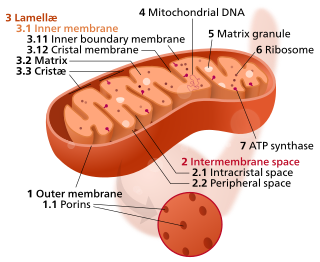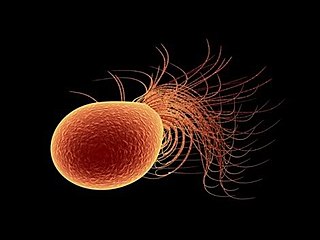
In the mitochondrion, the matrix is the space within the inner membrane. The word "matrix" stems from the fact that this space is viscous, compared to the relatively aqueous cytoplasm. The mitochondrial matrix contains the mitochondrial DNA, ribosomes, soluble enzymes, small organic molecules, nucleotide cofactors, and inorganic ions.[1] The enzymes in the matrix facilitate reactions responsible for the production of ATP, such as the citric acid cycle, oxidative phosphorylation, oxidation of pyruvate, and the beta oxidation of fatty acids.

Pyrococcus furiosus is a heterotrophic, strictly anaerobic, extremophilic, model species of archaea. It is classified as a hyperthermophile because it thrives best under extremely high temperatures, and is notable for having an optimum growth temperature of 100 °C. P. furiosus belongs to the Pyrococcus genus, most commonly found in extreme environmental conditions of hydrothermal vents. It is one of the few prokaryotic organisms that has enzymes containing tungsten, an element rarely found in biological molecules.
In enzymology, a strombine dehydrogenase (EC 1.5.1.22) is an enzyme that catalyzes the chemical reaction
In enzymology, a D-malate dehydrogenase (decarboxylating) (EC 1.1.1.83) is an enzyme that catalyzes the chemical reaction
In enzymology, a 2-oxoaldehyde dehydrogenase (NAD+) (EC 1.2.1.23) is an enzyme that catalyzes the chemical reaction
In enzymology, a 5-carboxymethyl-2-hydroxymuconic-semialdehyde dehydrogenase (EC 1.2.1.60) is an enzyme that catalyzes the chemical reaction

In enzymology, an aldehyde dehydrogenase (NAD+) (EC 1.2.1.3) is an enzyme that catalyzes the chemical reaction
In enzymology, a coniferyl-aldehyde dehydrogenase (EC 1.2.1.68) is an enzyme that catalyzes the chemical reaction
In enzymology, a 2,4-diaminopentanoate dehydrogenase (EC 1.4.1.12) is an enzyme that catalyzes the chemical reaction
Alanine dehydrogenase (EC 1.4.1.1) is an enzyme that catalyzes the chemical reaction
Alanopine dehydrogenase (EC 1.5.1.17) is an enzyme that catalyzes the chemical reaction
Beta-alanopine dehydrogenase (EC 1.5.1.26) is an enzyme that catalyzes the chemical reaction
In enzymology, a D-lysopine dehydrogenase (EC 1.5.1.16) is an enzyme that catalyzes the chemical reaction
Octopine dehydrogenase (N2-(D-1-carboxyethyl)-L-arginine:NAD+ oxidoreductase, OcDH, ODH) is a dehydrogenase enzyme in the opine dehydrogenase family that helps maintain redox balance under anaerobic conditions. It is found largely in aquatic invertebrates, especially mollusks, sipunculids, and coelenterates, and plays a role analogous to lactate dehydrogenase (found largely in vertebrates) . In the presence of NADH, OcDH catalyzes the reductive condensation of an α-keto acid with an amino acid to form N-carboxyalkyl-amino acids (opines). The purpose of this reaction is to reoxidize glycolytically formed NADH to NAD+, replenishing this important reductant used in glycolysis and allowing for the continued production of ATP in the absence of oxygen.
In enzymology, a L-amino-acid dehydrogenase (EC 1.4.1.5) is an enzyme that catalyzes the chemical reaction
In enzymology, a phenylalanine dehydrogenase (EC 1.4.1.20) is an enzyme that catalyzes the chemical reaction
In enzymology, a tauropine dehydrogenase (EC 1.5.1.23) is an enzyme that catalyzes the chemical reaction

Lactate dehydrogenase (LDH or LD) is an enzyme found in nearly all living cells. LDH catalyzes the conversion of pyruvate to lactate and back, as it converts NAD+ to NADH and back. A dehydrogenase is an enzyme that transfers a hydride from one molecule to another.
2-Formylbenzoate dehydrogenase (EC 1.2.1.78, 2-carboxybenzaldehyde dehydrogenase, 2CBAL dehydrogenase, PhdK) is an enzyme with systematic name 2-formylbenzoate:NAD+ oxidoreductase. This enzyme catalyses the following chemical reaction
2-Hydroxymuconate-6-semialdehyde dehydrogenase (EC 1.2.1.85, xylG [gene], praB [gene] ) is an enzyme with systematic name (2E,4Z)-2-hydroxy-6-oxohexa-2,4-dienoate:NAD+ oxidoreductase. This enzyme catalyses the following chemical reaction




